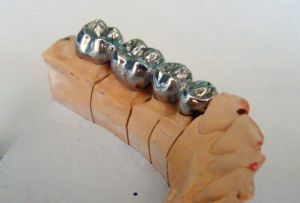 Everyone knows that a smile is a kind of business card. But not everyone can boast of healthy and beautiful teeth, however, significant progress in the development of dentistry in recent years allows you to bring your teeth closer to the cherished ideal with the help of numerous solutions and techniques.
Everyone knows that a smile is a kind of business card. But not everyone can boast of healthy and beautiful teeth, however, significant progress in the development of dentistry in recent years allows you to bring your teeth closer to the cherished ideal with the help of numerous solutions and techniques.
One of the most popular ways to reanimate the teeth is the installation of solid crowns.
content
- What is it used alloys
- Embodiments cast crowns
- indications and contraindications for installing
- Advantages and casting defects
- Pluses before presswork
- Pluses before cermet
- Fabrication process
- Installation Steps
- Properties oral care
- opinions are different. ..
- Price of the issue
What is it, alloys used
One-piece metal crown is made of a certain clava on the individual sizes.
Such crowns are used more often for prosthetics of molars. Under certain conditions, it is possible to use them in the so-called "smile line", that is, on the front teeth. If desired, you can install on the teeth cast crowns with or without coating, as well as with lining.
Cast crowns are used for the restoration of a damaged tooth and as a support for bridges.
For cast products, the following alloys are used:
- chromium together with nickel;
- chromium together with cobalt;
- alloys with titanium;
- alloys with gold or platinum.
In addition, if the crown is to be mounted on the front teeth, a plastic or ceramic patch is used as a supplement.
Variants of cast crowns
Depending on the doctor's recommendations and on the wishes of the patient, one of the following types of crown-cast crown can be installed:
- Without spray .The most budgetary and simple type of crown, the metal at the same glitters, as polished.
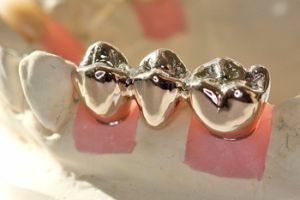
- With spraying .The coating "for gold"( titanium nitride) is applied to the crown by a vacuum-plasma method. Its surface becomes matte, however, from an aesthetic point of view, the teeth remain not very attractive. Titanium nitride, used as a spray, is able to influence the microflora and the state of the oral mucosa, in addition, a cast-crown with a sputtering can cause allergies.
- With facing .Cladding occurs with the help of a plastic or ceramic lining. Their service life is low, about 5 years, while the plastic will darken over time and can release harmful substances. Ceramics, in turn, is prone to cracks and chips.
Indications and contraindications to the installation
Dentists suggest using cast products if:
- the native tooth crown is badly damaged;
- teeth are abnormal and irregular in shape;
- need support for the installation of dental bridges;
- the tooth enamel is abnormally erased;
- there is an occlusion of one form or another, bruxism, parafunction of the masticatory muscles;
- wrong bite;
- tooth crown is abnormally small.
Contraindications:
- teeth with live pulp in children and adolescents;
- severe periodontitis.
Advantages and disadvantages of casting
Main advantages of cast crowns:
- long service life;
- tightness( excluding getting under the crown of food, saliva, paste);
- high strength.
Disadvantages:
- need to remove most of the tooth tissue;
- when the technological process of casting the crown is broken, possibly subsequent trauma to the gums;
- is not aesthetic( with a big smile and laughter, metal prostheses will be visible).
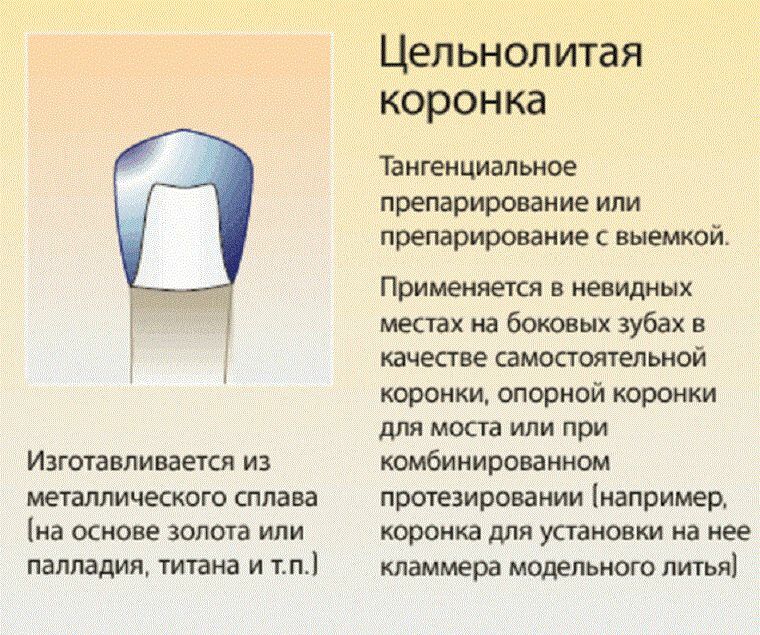
Advantages to the stamped products
Stamped crowns are an outdated method of prosthetics, which is gradually coming to naught. Many dental clinics still provide such a service, but it is not so much in demand.
To make a stamp, the impression is taken from the patient's jaw, and then the crown is formed on the gypsum model. A ready-made crown is tried on, eliminated flaws, if any, and put on permanent cement.
The price of such crowns is much cheaper than that of solid-cast ones, but they can not boast of durability and quality.
Cons of punching:
- loose fit to the gums, which is why it is possible to hit bacteria and foreign bodies under the crown;
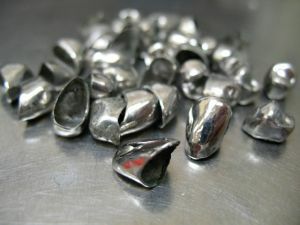
- frequent development of caries under the crown;
- development of galvanization, since a metal alloy of stamped crowns creates a negative potential, it is gradually corroded, and saliva in the oral cavity is an electrolyte. There is an excellent medium for the appearance of microcurrents, which can reach 150 mV;
- fast wear of metal, thickness of stamping only 0,3 mm;
- fragility of cement, which quickly crumbles, allowing you to get under the prosthesis of food particles.
Than cast crown is better:
- uses more advanced alloys with special additives, which makes the tooth surface smooth;
- long life, such crowns can last about 10 years;
- secure fit of the crown to the tooth;
- requires minimal preparation for a cast crown.
Advantages for cermets
Metal ceramic is a popular dental solution. From the aesthetic point of view, it is better to put the front teeth on them. If we talk about chewing, the preference remains for the whole-cast ones.
Advantages of cast crowns in front of cermet:
- , the crown has a smaller thickness compared to the cermet, so the tooth is not sharpened so much, more tooth is retained, which means that the tooth will last longer;
- metal-ceramic crowns are prone to cleavage, often require restoration, solid cast ones are deprived of such a problem.
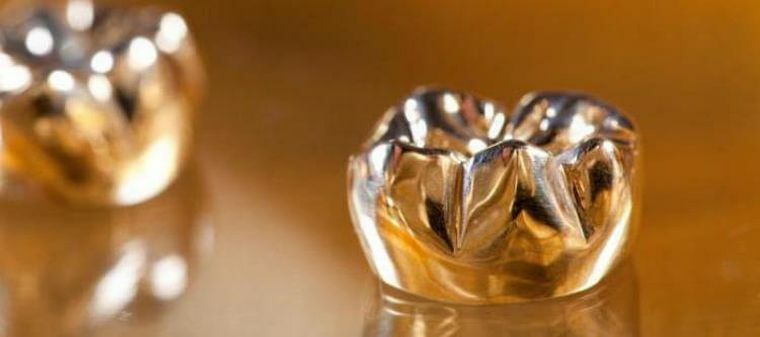
Whole-crown, as in the photo, will last much longer than punching
Manufacturing process
The production of solid cast crown involves the following steps:
- tooth is prepared;
- the anatomical impression is removed with the help of a special silicone mass;
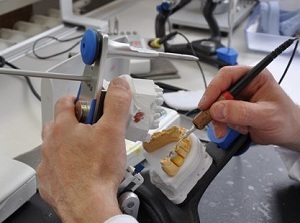
- fixes the central ratio of the jaws;
- the crown is adjusted, the occlusal relationship checked;
- the crown is fixed;
- is manufactured a demountable gypsum model;
- the wax composition of the future crown is modeled;
- wax is replaced with metal in the foundry laboratory;
- crown is machined, ground and polished.
The work of the master who makes such crowns is akin to the work of a jeweler.
Installation steps for
The installation is not just one day and it goes through several stages:
- at the first stage it is necessary to treat the existing diseases of teeth and oral cavity and remove plaque and deposits;
- further the tooth is grinded;
- cast crown is used and, if necessary, sent for revision;
- is usually placed on temporary cement to make a person understand whether it is convenient for him whether the bite is broken;
- last stage - the installation of the crown for permanent cement, while it sags into the gum approximately 0.2 mm.
While the production of solid crowns is taking place, temporary crowns are placed on the prepared teeth.
Features of oral care
Care of the oral cavity after the installation of the crown does not require any special effort. It is only necessary to thoroughly brush your teeth, rinse them after eating and visit the dentist on time. However, you should carefully consider the condition of the gums and avoid their inflammation.
With gingivitis and periodontitis, the crown may be unfrozen.
With the correct installation and use of good materials, the life of the solid crown is 15-20 years.

Opinions are different. ..
Reviews of people who made their choice in favor of crown crowns for correction of the dentition.
put its first crowns 10 years ago, then, on the advice of acquaintances, chose stamping, like a cheaper one, but the quality was not up to par. When I went to put new ones, I decided that there would be only one-piece ones. I put it and do not regret it.
Bite does not interfere, fit perfectly. I did not need to put ceramics on chewing teeth, the aesthetic side does not really bother me. But with their task cast crowns are doing fine.
Marina Nikolaevna, 64
Even in Soviet times, I put my crowns on 4 molars. After a while, they quickly went through and had to be put again. Then I did not know all the nuances. When I came to dentistry a few years ago, I learned that I had simple stamping, and now I can put high-grade cast crowns that are stronger and more convenient.
I put myself a crown with a coating and is very pleased, besides, from the mouth there was a constant taste of sour. The dentist explained that now more advanced alloys and from them there is no such unpleasant taste.
Genadiy
I put myself two solid crowns. Pottery is still an expensive treat, and the load on chewing teeth is large, it's better to have metal.
In dentistry, everything was done quickly and efficiently, the first time was put on temporary cement, everything turned out to be very convenient, as if it were. At the next reception put on a permanent cement. The crown goes a little under the gum, and at first there were not very pleasant feelings, but everything quickly passed.
Alina, 39
Price
The average price of a nickel-chrome cast-crown with no sputtering about 2000 rubles. Its cost is also gold-plated( titanium nitride) from 3000 rubles.
The price of crowns from precious metals is much higher and depends on the type of material.
